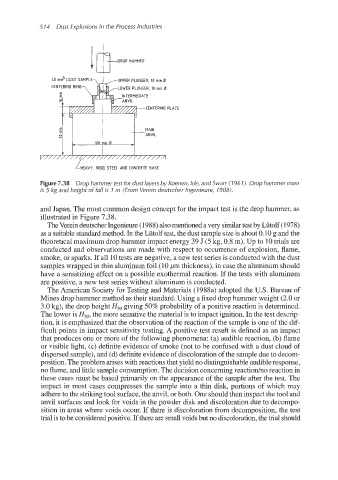Page 547 - Dust Explosions in the Process Industries
P. 547
5 14 Dust Explosions in the Process Industries
40 mrr7 OUST SAMPLE UPPER PLUNGER, 10 mm 0
CENTERING RING
CENTERING PLATE
ANVIL
FAIN
Figure 7.38 Drop hammer test for dust layers by Koenen, Ide, and Swart (196 1). Drop hammer mass
is 5 kg and height of fall is 1 rn (From Verein deutscher Ingenieure, 1988).
and Japan. The most common design concept for the impact test is the drop hammer, as
illustrated in Figure 7.38.
TheVerein deutscherIngenieure(1988) also mentioned a very similartest by Lutolf (1978)
as a suitable standard method. In the Liitolf test, the dust sample sizeis about 0.10 g and the
theoretical maximum drop hammer impact energy 39 J (5 kg, 0.8 m). Up to 10 trials are
conducted and observations are made with respect to occurrence of explosion, flame,
smoke, or sparks. If all 10 tests are negative, a new test series is conducted with the dust
samples wrapped in thin aluminum foil (10 pm thickness), in case the aluminum should
have a sensitizing effect on a possible exothermal reaction. If the tests with aluminum
are positive, a new test series without aluminum is conducted.
The American Society for Testing and Materials (1988a) adopted the U.S. Bureau of
Mines drop hammer method as their standard. Using a fixed drop hammer weight (2.0 or
3.0 kg), the drop height H,, giving 50% probability of a positive reaction is determined.
The lower is Hso,the more sensitivethe material is to impact ignition. In the test descrip-
tion, it is emphasized that the observation of the reaction of the sample is one of the dif-
ficult points in impact sensitivity testing. A positive test result is defined as an impact
that produces one or more of the following phenomena: (a) audible reaction, (b) flame
or visible light, (c) definite evidence of smoke (not to be confused with a dust cloud of
dispersed sample), and (d) definite evidence of discoloration of the sampledue to decom-
position. The problem arises with reactions that yield no distinguishableaudibleresponse,
no flame, and little sample consumption. The decision concerningreactiodno reaction in
these cases must be based primarily on the appearance of the sample after the test. The
impact in most cases compresses the sample into a thin disk, portions of which may
adhere to the striking tool surface,the anvil, or both. One should then inspect the tool and
anvil surfaces and look for voids in the powder disk and discoloration due to decompo-
sition in areas where voids occur. If there is discoloration from decomposition, the test
trial is to be consideredpositive. If there are smallvoids but no discoloration,the trial should

